 Valle Crucis, founded in 1201, is a superb example of a ruined Cistercian abbey, located less than an hour’s drive from the Chester-Wrexham area, in a lovely valley on the edge of a quiet stream that flows into the Dee. It has been extensively surveyed, the few documents relating to the site and its antecedents have been studied and the site has been excavated both in the 19th Century and in the 1970s. Importantly, most of the main features of the core buildings are identifiable, and can be discussed in terms of how the monastery was planned and used. All of these resources form a good basis for understanding how Valle Crucis was established and used, and what happened to it after it was “suppressed” or decommissioned following Henry VIII’s dissolution of most of Britain’s monasteries.
Valle Crucis, founded in 1201, is a superb example of a ruined Cistercian abbey, located less than an hour’s drive from the Chester-Wrexham area, in a lovely valley on the edge of a quiet stream that flows into the Dee. It has been extensively surveyed, the few documents relating to the site and its antecedents have been studied and the site has been excavated both in the 19th Century and in the 1970s. Importantly, most of the main features of the core buildings are identifiable, and can be discussed in terms of how the monastery was planned and used. All of these resources form a good basis for understanding how Valle Crucis was established and used, and what happened to it after it was “suppressed” or decommissioned following Henry VIII’s dissolution of most of Britain’s monasteries.
 This is the first of a series of posts looking at the monastery. These posts are quite long. Valle Crucis, is used in this series of posts to introduce not only this particular abbey, but also the ideas that lead to monasticism, different monastic orders and the distinctive architecture that defines most of the monastic orders in Britain.
This is the first of a series of posts looking at the monastery. These posts are quite long. Valle Crucis, is used in this series of posts to introduce not only this particular abbey, but also the ideas that lead to monasticism, different monastic orders and the distinctive architecture that defines most of the monastic orders in Britain.
An “order” is a shared monastic tradition, a set of spiritual ideals often spelled out in considerable detail in rules that covered everything from how many times a day a monk should pray, communally or individually, to where and when they could speak, eat and sleep, and what work they should engage in. All orders involve a degree of renunciation and isolation by communities of monks. Monastic architecture reflects both the need to gather a community in one establishment, adhering to a single set of rules, and the need to divorce that establishment from the rest of the world. Unlike monks, friars could leave the monastic community (friary) to preach and tend to the poor, and were often located in urban contexts, but other orders chose to confine themselves to an abbey to focus their attentions on worship and scholarly activities that celebrated God. Some chose to locate themselves far from other human habitation. All were what is now termed Catholic, and all owed allegiance to the Pope, as well as to the heads of their own order, and to the founders who endowed their properties with land and resources. The religious orders of the 12th and 13th Centuries in Britain were differentiated from one another based not on their religious beliefs, but on their ideas about how best to worship and celebrate God. They dedicated themselves to spirituality and worship in different ways, based on traditions established in the history of monasticism.
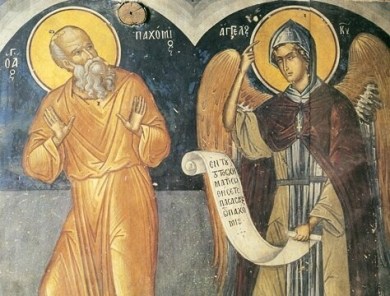
St Pachomius in St Shenouda Monastery, Egypt. Source: St Shenouda Monastery website
Monasticism grew out of an early tradition in 3rd-4th Century A.D. Egypt where the devout might abandon their communities to live as hermits in the desert hills and mountains, divorced from anyone else. They had as their models St John the Baptist and Jesus, both of whom had engaged in devout isolation in the desert. Hermits began to organize themselves into communities that focused on offering guidance and communal prayer whilst still offering isolation from the distractions of secular life. In the 4th Century, former soldier Pachomius, having followed the eremitic path in the Egyptian desert to live the life of a hermit, heard a voice telling him to establish a community for hermits like himself, a coenobitic (“common living”) way of combining isolation from the outside world with communal support and guidance. This acknowledged that whilst individuals might seek out a life divorced from the material, they could well need help to achieve the sort of enlightenment that they were seeking. These communities were therefore sources of knowledge, wisdom and education as well as worship. He established his monastery in Tabennisi in Egypt, and simultaneously began to develop the first set of formal rules for guiding life in a monastery, which grew over time. The rules combined prayer, solitude and work in a communal and very isolated environment, a difficult balance to strike. This was successful and soon spread. Monasteries began to appear throughout the Mediterranean from where they spread into Europe.
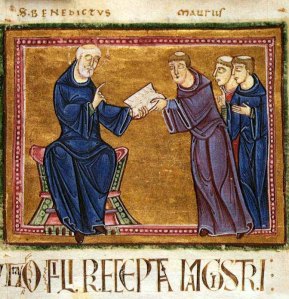
A 12th Century interpretation of St Benedict delivering his monastic rule in the 6th Century AD. Source: Wikipedia, via Monastery of St. Gilles, Nimes France (1129)
In 6th Century Italy, St Benedict developed another set of rules for monastic living that required not only individual prayer and communal worship, but outlined a strict regime of living that included eating merely for fuel rather than enjoyment, a largely vegetarian and very narrow diet, and the requirement for manual work, including contributing to building projects and labouring in the fields. The concept of an abbey emerged, a religious establishment consisting of both a monastery and a church in a single complex, housing a community of monks who do not leave the premises. St Benedict’s form of monasticism was popular and spread throughout Europe.
As Benedictine monasticism spread and developed its own personality over the centuries, the strictness of St Benedict’s rules was often abandoned to enable a much more comfortable lifestyle, with an emphasis on liturgy rather than work, a varied and rich diet that included meat, and an emphasis on glorifying God through rich works of art and generous patronage. Some abbots became involved in religious and state politics beyond the abbey walls, and became influential in their own right, far from the unworldly vision of monks that St Benedict had promoted. In the 12th Century this more opulent version of Benedictine monasticism was epitomized by the Cluniac order of monks (named after their abbey at Cluny in France). The Cluniac order was the apogee of this desire to express devotion through liturgy and art, the elaborate and rich monasteries home to opulent treasures, art works, tapestries and fabulous stained glass that were intended to both reflect and celebrate the glory of God, and the monks entertained lavishly, rubbing shoulders with the rich and powerful. This trend sat ill with those who sought a simpler, modest, withdrawn and hard-working way of serving God, true to St Benedict.

Johann Petr Molitor, Cistercian monks, murals in the Capitular Hall, Cistercian Abbey Osek, North Bohemia, before 1756. Source: Wikipedia, from the Cistercian Abbey of Osek, North Bohemia
During the early Middle Ages, the Cistercians, named after their first abbey, the 1098 New Monastery at Cîteaux (Cistercium in Latin) in France, set about returning to the values of St Benedict, which led to the reformation of some branches of Benedictine-based monasticism. New Cistercian abbeys were established as a network of child abbeys, each secondary to its own mother, and all owing allegiance to the founding house at its core, Cîteaux. Each new abbey could spawn one or more other abbeys. The third abbot of the new Cistercian order, Stephen Harding, wrestling with the problem of how to ensure that the Cistercian principles would not submit to similar decay, retained the Cluniac’s governing principle of the first abbey being the mother for all subsequent houses of the order, to ensure consistency and standardization throughout the order. This contrasted with Benedictine abbeys that adhered to the same 6th Century monastic rules proposed by St Benedict, but were wholly independent of one another.
Harding’s own guidelines, building on those of St Benedict, also included obligations that had to be acted upon on a regular basis by the entire family of abbeys. One of these was that all the same liturgies should be used in all abbeys. A unique requirement was that all abbots should attend, annually, the General Chapter at Citeaux, a meeting of all the abbots that discussed changes, challenges and difficulties, and enforced discipline. Another innovation was that when an existing abbey founded a new house, the mother abbey was obliged to arrange annual visits to its daughter houses to ensure that the standards, values and rules of the Cistercian order were being maintained. In this way, for the 11th,12th and much of the 13th centuries, the Cistercians maintained control and uniformity over a vast family of monastic houses, including Valle Crucis. The monks wore undyed habits, unlike the other Benedictine orders whose habits were dark brown or black. Accordingly, they became commonly known as the White Monks.

Citeaux Abbey. Source: Wikipedia
The Cistercians combined worship with hard work in remote places that encouraged contemplation, eliminated distractions and enabled focus on a communal but pared down livelihood that was far more in keeping with St Benedict’s more spartan ideals. After Cîteaux, the most important Cistercian monastery, responsible for evangelizing on behalf of the Cistercians, was Clairvaux (founded 1115), which was the home base of abbot St Bernard. St Bernard was a restless and vocal monastic propogandist of the 12th Century who, in contradiction to the rules of the order, travelled far and wide to bring the Cistercian message to the western world, and whose sayings are still widely quoted: “Arouse yourself, gird your loins, put aside idleness, grasp the nettle and do some hard work.” He was an advocate of crusades, connected with monarchs, politicians and other religious hierarchy, promoted the cult of the Virgin Mary, and became an unexpected and influential celebrity and icon, the poster-child of the Cistercian message. Gascoigne calls him “the most influential monk of the Middle Ages.”

St Bernard in his white robes holding a delightfully improbable demon at his feet. Marcello Baschenis, c.1885. Source: Wikipedia
Very quickly, new Cistercian abbeys proliferated in Europe and across Britain, always in isolated locations, each connected as a daughter to its mother abbey, to which it owed homage and loyalty. Clairvaux was the mother abbey for Whitland in south Wales, which was established by monks from Clairvaux itself. Whitland in turn established other abbeys including Strata Marcella near Welshpool, and this abbey in turn established Valle Crucis. It took 86 years from the foundation of Clairvaux until the foundation of Valle Crucis, but it was only four monastic steps from St Bernard, and that sense of proximity must have resonated at Valle Crucis, as with all the abbeys in Wales.
Every Cistercian abbot had to return from his abbey to Citeaux every year for what was known as the General Chapter, a great conference of abbots. This was the case even for abbeys that were located overseas, and the British abbeys were subject to this costly and time-consuming annual trek. Also on an annual basis, the abbot or his prior if he had one (the abbot’s second in command) would visit a given abbey’s daughter abbeys to ensure that everything was running according to the original Benedictine plan. This led to a degree of standardization and adherence to the order’s rules that was not necessarily seen in the other orders.
The remains at Valle Crucis offer a great opportunity for discussing the main points of Cistercian architecture, life and economic strategy. It is a site that reinforces many of the observations that have been made about Cistercian monastic traditions throughout Britain, but which is also interesting in its own right. The Welsh abbeys provide a particular opportunity for considering how their circumstances may have differed from their English counterparts, due to a series of factors including the patronage of Welsh abbeys by the Welsh princes, the wars fought on monastic land by Edward I and Owain Glyndŵr, and the character of the landscape in which the abbeys were built. Other orders will be discussed in the future.
Introducing Valle Crucis
In 1201 bValle Crucis was built in a scenic valley beneath the Horseshoe Pass near Llangollen, on the banks of Nant Eglwyseg, a fast-moving stream that ran into the Dee and now feeds the Llangollen canal.
Both choir (or quire) monks and lay brothers were housed at Valle Crucis. The choir monks and lay brothers lived different lives. Their refectories, dormitories and latrines were all quite separate, and their roles within the abbey were clearly delineated. Although the lay brothers would worship in the church, they were confined to the nave and a screen separated them from the choir brothers. The lay brothers ate more advantageously, as they needed a better diet to support them in their daily work. Cistercian orders worshiped seven times a day and once at night, and engaged in scholarly pursuits, but were also expected to engage in manual labour, contributing to the work carried out by lay monks. Lay monks (conversi) were illiterate and worked the land, but were resident at the monastery. They had their own separate quarters for sleeping and eating, and were confined to a section of the church that was divided from the parts of the church used by the quire monks. Their church worship was much less frequent than that undertaken by quire monks, as most of their day was taken up by agriculture, crafts and building works.
The name of Valle Crucis is Latin, meaning Valley of the Cross, a reference to the 9th Century inscribed Pillar of Eliseg that was erected to commemorate the ancestors of Concenn of Powys, a Welsh chieftain who died on pilgrimage to Rome in 858. Eliseg was Concenn’s great-grandfather. The inscription is now illegible but was recorded in 1696 and lists great deeds of ancestors, presumably with a view to establishing an incontrovertible connection to the lands on which the cross was constructed.
Survey, excavation, restoration and modern research
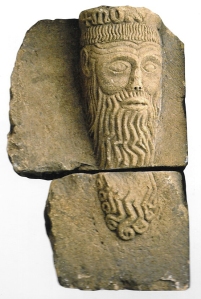
Carved head found in the refectory during excavations, and now rather a long way from home in the National Museum in Cardiff. Source: Evans 2008, p.47
Documentary resources are few and far between for Valle Crucis, so other ways of exploring the history of the site have been employed. The documentary archives of other monasteries and of related properties have helped to provide some additional information, but the documentary picture remains very threadbare.
Because of the architectural and functional standardization of monastic establishments, it has been possible to extrapolate the roles of much of the site’s key buildings by comparison to other Cistercian abbeys, but this only takes one so far.
Observing the above-ground architecture has taken matters a lot further, telling a story of a major fire forty years after the foundation of the abbey, and the changes in architectural direction that had to be taken as a result. As the decades and centuries passed, changes in Cistercian values and ideas are captured in the architectural features and new decorative motifs. This rich source of information has been supplemented by data that has come from the ground.
One of the fads of the 19th Century was antiquarianism, the investigation of ancient sites of all ages. Excavations became popular activities, although often hair-raising in the level of destruction achieved in the process of the pursuit of dazzling objects. Valle Crucis did not escape this attention, and a series of archaeological excavations were carried out in both the middle of the 19th century, and in its latter half. An anonymous letter to Archaeologia Cambrensis dating to 1863 by a visitor to Valle Crucis condemned the mid 19th Century excavations by W.W.E. Wynne, but the subsequent excavations by Harold Hughes appear to have been carried out with rather more integrity.
In 1970 the site was excavated by Lawrence Butler. He reported on the findings, including the chronological sequences from the site, and full details of the pottery in 1976. The pottery was limited in type and form but covered the full range of the site from construction to dissolution. The faunal remains were analyzed by the ever excellent Graeme Barker as part of that project’s post-excavation work, to provide information about diet and economic activities, and his report was published in the same year. The results of this particular project are of great interest as Butler found evidence of the earliest clearance of the site and was able to clarify details of fire, flood and alterations to the architecture in line both with these events and in response to the relaxation of Cistercian rules.
Because work has been concentrated on the core abbey buildings, it is less clear how the larger monastic precinct was organized. This is the area surrounding and beyond the abbey’s heart, that were essential to the abbey’s economic survival, in which agricultural and activities took place, and in which vital supplies were stored for consumption or trade.
Restoration work began with clearance of the site for excavation, but more ambitious work followed. Sir Gilbert Scott, the renowned Victorian architect, was employed to repair the west front of the church in 1872, and Sir Theodore Martin restored part of the east end in 1896. The difference in the stonework at the and the site has been made safe for visitors.
After passing into the hands of the Ministry of Works in 1950, Valle Crucis was eventually transferred into the care of Cadw in 2008, which retains responsibility for the site. Between them the site was made safe for visitors and Cadw has expended some effort on information signage to help visitors understand some of the site’s history.
How Valle Crucis and other Welsh abbeys were founded
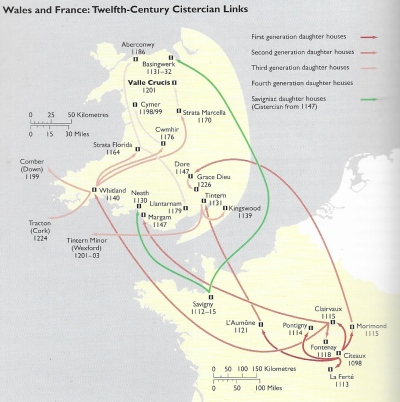
12th Century links between Cistercian monasteries. Source: Evans, D.H. Valle Crucis Abbey (Cadw). Although Citeaux, the node for all Cistercian abbeys, established early new bases in France, it was Clairvaux under the lead of St Bernard that was responsible for the earliest new abbeys in Wales. Of these Whitland was the most important for the northward spread of monasticism. The green lines emanating from Savigny reflect the Savignac order, which merged with the Cistercians after only 20 years, in 1147. So although Basingwerk in the north and Neath in the south were founded as Savignac orders, after 1147 they were brought under the rule of the Cistercians at Citeaux.
Valley Crucis was at the northeastern end of a branch of a monastic chain that spread from south Wales to the north over a period of some 60 years during the 12th Century, building on a much older European monastic tradition. The Cistercian order of monks spread through Wales during the 12th Century AD from the of Wales where it was established by monks from the French monastery Clairvaux, forming an eastern and a western chain of monasteries.
The first new Cistercian abbeys were established in Wales in the wake of the Norman conquest, the earliest at Tintern in 1131, and had a distinctly Anglo-Norman flavour. However, a second strand of Cistercian monasticism spread in Wales. It began at Whitland (Abaty Hendy-gwyn ar Daf), founded in 1140 by monks from St Bernard’s abbey at Clairvaux, second only to the Cistercians’ founding abbey at Citeaux. Whitland spawned a series of abbeys that were funded by the native Welsh princes and were populated mainly by Welsh monks, a pura Wallia (Welsh Wales) version of Cistercian monasticism that nurtured Welsh literature and learning. This spread into the poorer and more remote areas of Wales.
 Valle Crucis was founded in 1201, the daughter house of Strata Marcella Abbey (Abaty Ystrad Marchell) near Welshpool, founded by Owain Cyfeiliog, prince of southern Powys, itself a daughter house of Whitland. Establishing an abbey was an expensive undertaking, both in terms of its construction and providing it with the resources to ensure ongoing economic security. Accordingly, every new abbey required an endowment by a donor, someone with enough land and wealth to give some of it away in return for divine good will and the prayers offered by the monks for the souls of the donor and his family. The donor usually required a guarantee that they would be buried within the abbey church, and that their family would be buried either within the church itself or within the monastery precinct. Monks were considered to have a hotline to God. Having dedicated their lives to Him, and living sin-free lives, they built up a surplus of virtue and influence that could be employed on behalf of the living in order to provide for them in the afterlife, an intercession to minimize the impact of sins committed in life. Valle Crucis Abbey was founded by Prince Madog ap Gruffydd.
Valle Crucis was founded in 1201, the daughter house of Strata Marcella Abbey (Abaty Ystrad Marchell) near Welshpool, founded by Owain Cyfeiliog, prince of southern Powys, itself a daughter house of Whitland. Establishing an abbey was an expensive undertaking, both in terms of its construction and providing it with the resources to ensure ongoing economic security. Accordingly, every new abbey required an endowment by a donor, someone with enough land and wealth to give some of it away in return for divine good will and the prayers offered by the monks for the souls of the donor and his family. The donor usually required a guarantee that they would be buried within the abbey church, and that their family would be buried either within the church itself or within the monastery precinct. Monks were considered to have a hotline to God. Having dedicated their lives to Him, and living sin-free lives, they built up a surplus of virtue and influence that could be employed on behalf of the living in order to provide for them in the afterlife, an intercession to minimize the impact of sins committed in life. Valle Crucis Abbey was founded by Prince Madog ap Gruffydd.
Prince Madog ap Gruffydd controlled the territory of Powys Fadog from the Tanat valley in the south to the edge of Chester from 1191 until his death in 1236, and was an ally of his cousin Llywelyn ap Iorwerth (Llywelyn the Great), prince of Gwynedd, d.1240. In accordance both with tradition, and to fulfil the terms of his original financing and support of the abbey, he was buried in the abbey church at Valle Crucis, although the exact site of the grave has been lost. The map above left shows the territorial divisions in Wales in 1267, with Powys Fadog bordering Chester, Gwynedd, southern Powys (Powys Wenwynwyn) and England.
Valle Crucis was supplied with at least twelve monks (considered by St Benedict to be the minimum number for founding a monastery, following the twelve apostles), possibly thirteen, who were installed in temporary accommodation with a wooden church. Work would have begun immediately on the stone church, the sacristy and the accommodation, and the 1970 excavation found unmistakeable signs of this work.
Choice of location
The map to the left (Ordnance Survey SJ24/34) shows the relative locations of Valle Crucis Abbey, the Pillar of Eliseg and Castell Dinas Brân, all a short drive from Llangollen, which was probably a large village that would have benefitted from the proximity of the monastery and its associated farms (known as granges).

Ordnance Survey map SJ24/34, showing the relative locations of Valle Crucis Abbey, the Pillar of Eliseg and Castell Dinas Brân (the latter not built until 1270, 69 years after the foundation of Valle Crucis)
The Cistercian ideal of a contemplative existence away from distractions meant that new abbeys were sited where monks could practise their devotions in relative seclusion, although not in complete isolation. They were often near to well-established routes, and they always located themselves near to water that would be used for drinking, cooking, cleaning, ritual purification, as well as fishing and sometimes for powering water mills. Abbeys were supposed to be economically self-sufficient, so abbeys still needed to be near enough to manors and villages to enable them to trade their produce, mainly agricultural, in exchange for the basics required for sustaining the abbey, both the choir monks (the dedicated monks within the monastery) and the conversi or lay brotherhood.
Although little is known about Llangollen in the late 12th Century, there was some type of settlement recorded there based around a church, and in 1284, Edward I granted the manor of Llangollen to Roger Mortimer, together with the rights for a weekly market and two annual fairs. Llangollen was far enough away for monks to feel that they were isolated from civilization, but near enough to a village to enable contacts to be established if required for sourcing produce, raw materials and other goods. The site of the abbey was clearly idyllic. The following is an evocative excerpt from a paper by John Williams, who reported on the abbey in 1846 in the journal Archaeologia Cambrensis:
Luxuriantly watered by a clear stream and sheltered by high hills, the sides of which are gracefully ornamented by trees, the place altogether appears as if especially intended to be the home of peace and happiness – a paradise for restored man, where he might securely worship his Creator and cultivate the graces of heaven implanted in his soul.

The sad remains of Strata Marcella Abbey, which supplied the founding monks of Valle Crucis. Source: Coflein website – RCAHMW, taken by C.R. Musson, 2/1/1995.
The founding monks of Valle Crucis from Strata Marcella near Welshpool certainly thought so. They moved the residents of the existing hamlet of Llanegwest to a new location in order to establish themselves in this particular paradise in the form of a fine abbey. Llanegwest was probably a fairly tiny settlement, and it was relocated to Maelor Gymraeg (on the far northeastern border). This was by no means unusual, and there are enough records of hamlets and villages being moved to make way for a monastic establishment for this to be seen as a fairly standard (if somewhat ruthless) act in the establishment of a new Cistercian abbey.
The Cistercians were renowned for their use of water, which in some abbeys included sophisticated networks of sunken drains that fed into and out of monastic buildings. The siting of Valle Crucis next to the Eglwyseg was essential for sourcing water that was used for cooking, cleaning, washing, for use in rituals and for creating a fish pond and a drainage system to flush both the choir monks’ and lay brothers’ latrines.
The pond is an expanded version of the original one, and is the only one surviving in Wales. As early Cistercians could not eat meat under St Benedict’s rules, except on certain nominated days, fish was often an important component of the diet. As the rules relaxed, meat found its way into the diet on more than just special days, but in the early abbeys fish was often responsible for providing much-needed protein.
The latrines, located on the first floor at the end of the dormitories, were flushed by drains below, which diverted fast-moving stream water to clear waste back into the stream, presumably downriver of the monastery. Cleanliness was an important component of monastic life, with monks washing their hands before each meal, and latrines associated with the devil.

Pillar of Eliseg by David Parkes 1809. Source: National Library of Wales
Finally, the Pillar of Eliseg may or may not have influenced the location of the abbey, even though it provided the abbey with its name. It is, however, entirely possible that the presence of the ancient cross as a clear and ancient statement of Christian affiliation would have been particularly attractive to the new abbot and his monks. Perhaps more significantly, it was probably particularly resonant for the founder-patron of the abbey, Prince Madog ap Gruffydd, embedded as the monument was with memories of the past inhabitants of the region who sought to defend it against all-comers. With the Marcher Lords at the borders and the English beyond, Madog probably felt a close affinity with Concenn and his predecessors. The cross still stands to the north of the abbey, but is considerably shorter, with bits missing, including the top, base and arms of the cross. In the view to the right by David Parkes, dated 1809, the remains of Valle Crucis are visible at the lower left of the image.
I had initially assumed that the siting of Valle Crucis took into account the proximity of Dinas Brân, a Medieval castle that was also located in the Vale of Llangollen and can be seen from the abbey. The castle was not, however, built until 1270.
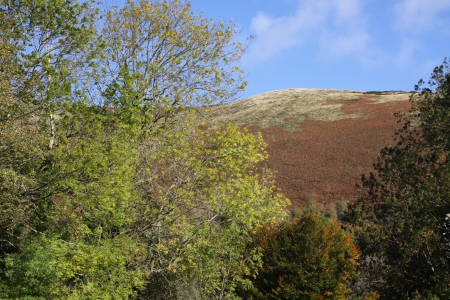
View from the interior of Valle Crucis. I find it hard to get my head around the idea that this and other very narrow views were all that the monks would have seen. They could not explore the environment in which their abbey was located, because they were confined to the monastic precinct. They could merely see it, never truly experience it.
The remains of Valle Crucis
Valley Crucis provides a very useful template for understanding other monasteries in the Benedictine tradition, all incorporating a church and the main monastic buildings arranged around a square cloister, consisting of a walkway connecting the buildings around a garden or “garth.”

Cadw site plan, with photographs of mine added to show the relative location of some of the key features (click to expand).
Above is a site plan of Valle Crucis, which adopted the typical layout of a Benedictine abbey that the Cistercians had adopted, basing themselves on the Benedictine rule. The earliest known abbey in Britain that adopted this basic layout was Glastonbury Abbey. Part 2 will show this image again, and look at these and other features in detail, discussing how they reflect historical developments from the foundation of the abbey at the beginning of the 13th Century, via fire, flood, fluctuating fortunes and changing ideas to its dissolution in the mid 16th century.
As I mentioned at the start of this post, Valle Crucis is not merely of interest as a component of the Vale of Llangollen landscape, but is a useful representative of both Welsh and English Cistercian traditions. It both exemplifies many of the historical details that have been assembled about Cistercian monasticism in Britain, and provides an impressive volume of data that both reinforces existing knowledge and adds to it. Some of this will be explored further in the next three posts.
This post, Part 1, has introduced the Cistercian order and explained why Valle Crucis was located where it is. The next post, part 2 looks at the organization of the abbey in terms of its purpose and how it was built to meet the needs of the monastic community, looking at each room in turn. All parts are available, as they are written, by clicking on the following link: https://basedinchurton.co.uk/category/valley-crucis-abbey/
Sources for the Valle Crucis series
Resources that were of particular use are picked out in bold.
Books and papers
Anonymous (A. Traveller) 1863. Valle Crucis Abbey – Correspondence To the Editor of Archaeologia Cambrensis. Archaeologia Cambrensis, 3rd series, No.33, January 1863, p.68-72
https://journals.library.wales/view/2919943/2995788/67#?xywh=-1466%2C103%2C5111%2C3522
Aston, M. 2000. Monasteries in the Landscape. Tempus

Barker, G. 1976. Diet and Economy at Valle Crucis: The Report on the Animal Bones. Archaeologia Cambrensis 125 (1976), p.117-126
Butler, L.A.S. 1976. Valle Crucis Abbey: An Excavation in 1970. Archaeologia Cambrensis 125 (1976), p.80-116
https://journals.library.wales/view/4718179/4747123/95#?xywh=-1521%2C-15%2C5975%2C3940
Burton, J. and Kerr, J. 2011. The Cistercians in the Middle Ages. Boydell Press
Burton, J. and Ströber, K. 2015. Abbeys and Priories of Medieval Wales. University of Wales Press
Cantor, N. 2002. In the Wake of the Black Death and the World it Made. Perennial
Carr, A.D. 1970. An Aristocracy in Decline: the Native Welsh Lords after the Edwardian Conquest. Wesh History Review 5 (1970), p.103-29
Clwyd and Powys Archaeological Trust. Historic Settlement Survey – Denbighshire – 2014. Llangollen SJ 2150 4190, 105978.
https://cpat.org.uk/ycom/denbigh/llangollen.pdf
Coppack, G. 1990. Abbeys and Priories. Batsford.
Davies, J. 2007 (3rd edition). A History of Wales. Penguin
Evans D.H. 2008, Valle Crucis Abbey, Cadw
Edwards, N. 2008. The Pillar of Eliseg. In: Evans D.H., Valle Crucis Abbey, Cadw
Gascoigne, B. 2004 (revised edition). A Brief History of Christianity. Constable and Robinson
Greene, J.P. 1992. Medieval Monasteries. Leicester University Press
Gresham, C.A. 1968. Medieval stone carving in North Wales: Sepulchral slabs and effigies of the thirteenth and fourteenth centuries. University of Wales Press
Hughes, H. 1894, Valle Crucis Abbey. Archaeologia Cambrensis, 5th series, 11:43 (1894), p.69-85, 257-75
https://journals.library.wales/view/2919943/3009987/#?xywh=-853%2C-196%2C3885%2C3913
Hughes, H. 1895. Valle Crucis Abbey. Archaeologia Cambrensis, 5th series, 12:45 (1895), pp. 5-17
https://journals.library.wales/view/2919943/3010260/#?xywh=-853%2C-196%2C3885%2C3913
Huws, D. 2000. Medieval welsh Manuscripts. University of Wales Press
Jenkins, G.H. 2007. A Concise History of Wales. Cambridge University Press
Jones, O.W. 2013. Historical writing in Medieval Wales. PhD thesis, Bangor University
https://research.bangor.ac.uk/portal/files/20577287/null
Jones, O.W. 2020. The Most Excellent Princes: Geoffrey of Monmouth and Medieval Welsh
Historical Writing. In Henley, G. and Smith, J.B. (eds.) A Companion to Geoffrey of Monmouth. Brill
Kelley, J. 2006. The Great Mortality. An intimate history of the Black Death. Harper Perennial
Kerr, J. 2006. Life in the Medieval Cloister. Continuum
Lewis, S. 1849. Holt in A Topographical Dictionary of Wales: ‘Heyop – Holyhead’, p.418-430.
Available on British History Online https://www.british-history.ac.uk/topographical-dict/wales/pp418-430#h3-0009
Long, J.F. 1992. 1147 Rejected: A study of Cistercian and Savignac Possessions in England and Wales 1127-1176. Master of Arts Dissertation, University of Manitoba, December 1992
Miller, D. 2017. Sing a New Song. The Spirit of Cistercian Liturgical Reform and the 1147 Hymnal. M.A. Thesis, Central European University, Budapest. https://www.etd.ceu.edu/2017/miller_dane.pdf
Morris, R.M. 1987. Bare Ruined Choirs. The Fate of a Welsh Abbey. Stanley Thornes Ltd.
Platt, C. 1984. The Abbeys and Priories of Medieval England. Chancellor Press
Pratt, D. 2011. Valle Crucis abbey: lands and charters. Denbighshire Historical Society Transactions
Price, G.V. 1952, Valle Crucis Abbey. Hugh Evans and Sons / The Brython Press
Rees, W. 1920. The Black Death in England and Wales, as Exhibited in Manorial Documents. Transactions of the Royal History Society. vol.3, Dec.1920, p.115-135
Robinson, D. 2006. The Cistercians in Wales. Architecture and Archaeology 1130-1540. Society of Antiquaries London
Rogers, M. 1992. The Marcher Lordship of Bromfield and Yale. Unpublished PhD. University College Wales, Aberystwyth. Available on EThOS at
https://ethos.bl.uk/OrderDetails.do?uin=uk.bl.ethos.262474
Silvester, R.J., and Hankinson, R., 2015. The Monastic Granges of East Wales. The Scheduling Enhancement Programme: Welshpool. Clwyd-Powys Archaeological Trust (CPAT)
Southern, R.W. 1970. Western Society and the Church in the Middle Ages. Penguin
Stephenson, D. 2016. Medieval Powys. Kingdom, Principality and Lordship 1132-1293. Boydell and Brewer
Ströber, K. 2008. Social Networks of Late Medieval Monasteries. In Burton, J. and Ströber, K. Monastery and Society in the British Isles in the Late Medieval Period. Boydell and Brewer
Venning, T. 2015 (second edition). The Kings and Queens of Wales. Amberley
Waddell, C., 1993. Towards a new provisional edition of the Statutes of the Cistercian General Chapter, c. 1119-1198. In (eds.) F. R. Swietek and J. Sommerfeldt. Studiosorum Speculum: Studies in Honour of Louis J. Lekai. Kalamazoo, p.384-419.
Williams, D. 1984. The Welsh Cistercians. Cyhoeddiadau Sistersiaidd
Williams, D. 1990. Atlas of Cistercian Lands in Wales. University of Wales Press
Williams, G. 1976 (second edition). The Welsh Church from Conquest to Reformation. University of Wales Press
Williams, H., Smith, G, Crane D. and Watson, A. 2018. The Smiling Abbot: Rediscovering a Unique Medieval Effigial Slab. Archaeological Journal, 175, 2, p.255-291
DOI: 10.1080/00665983.2017.1366705
Williams, J. 1846. Valle Crucis Abbey. Archaeologia Cambrensis, 1 , 1846 p.17-32, 151-153, 279-280
https://journals.library.wales/view/2919943/2989093/17#?xywh=-893%2C45%2C3900%2C3929
Wynne, W. W. E. 1848. Valle Crucis Abbey. Archaeologia Cambrensis, 3:11 (1848), p.228-229
https://journals.library.wales/view/2919943/2991333/41#?xywh=-913%2C-241%2C3920%2C3949
Wynne, W. W. E. 1849. Excavations at Valle Crucis Abbey. Archaeologia Cambrensis, 4:13 (1849), p.22-27
https://journals.library.wales/view/2919943/2991554/21#?xywh=-849%2C-1035%2C3920%2C3949
Wynne, W. W. E. 1851. Excavations at Valle Crucis Abbey. Archaeologia Cambrensis, new series, 8 (1851), p.282-284
https://journals.library.wales/view/2919943/2990655/21#?xywh=-893%2C-221%2C3920%2C3949
Wynne, W. W. E. 1852. Excavations at Valle Crucis Abbey. Archaeologia Cambrensis, new series, 10 (1852), pp. 93-96
https://journals.library.wales/view/2919943/2990849/12#?xywh=-893%2C-199%2C3900%2C3929
Yorke, T. 2004. The English Abbey Explained. Monasteries – Priories. Countryside Books
Ziegler, P. 1969. The Black Death. William Collins, Sons and Co.
Websites
Ancient and Medieval Architecture
Llantysilio – Valle Crucis Abbey
https://tinyurl.com/8fuybma9
ArchaeoDeath – Death and Memory, Past and Present (blog)
Valle Crucis – Reused Ruins, Water and Death In Absentia by Professor Howard Williams
https://howardwilliamsblog.wordpress.com/2014/02/12/valle-crucis-reused-ruins-water-and-death-in-absentia/
The Smiling abbot of Valle Crucis
https://howardwilliamsblog.wordpress.com/2016/03/31/the-smiling-abbot-of-valle-crucis-an-archaeodeath-exclusive/
Valle Crucis tags
https://howardwilliamsblog.wordpress.com/tag/valle-crucis/
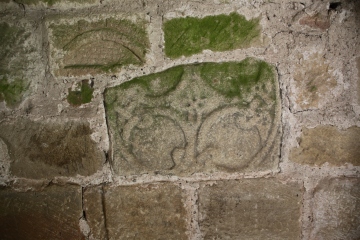 Coflein
Coflein
Valle Crucis
https://coflein.gov.uk/en/site/95205/
English Heritage
Valle Crucis Abbey
https://cadw.gov.wales/visit/places-to-visit/valle-crucis-abbey
An Essay on Cistercian Liturgy by Dr Julie Kerr
Cistercians in Yorkshire, University of Sheffield
www.dhi.ac.uk/cistercians/cistercian_life/spirituality/Liturgy/Cistercian_liturgy.pdf
Monastic Wales
Valle Crucis (Abbey)
https://www.monasticwales.org/browsedb.php?func=showsite&siteID=35
The Cistercians in Yorkshire Project
https://www.dhi.ac.uk/cistercians/
WordProject
Psalms (audio readings)
https://www.wordproject.org/bibles/audio/01_english/b19.htm
afsdfsdfs


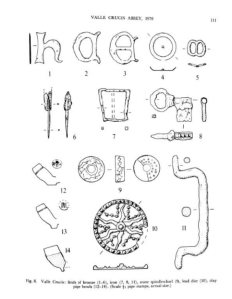



PS I have a copy of the S+N Buck prints 1732 Valle Crucis Abbey and Castle Dinasbran.
LikeLike
I love the Buck prints. They are a brilliant bridge between past and present, showing how some of these old buildings were faring.
LikeLike